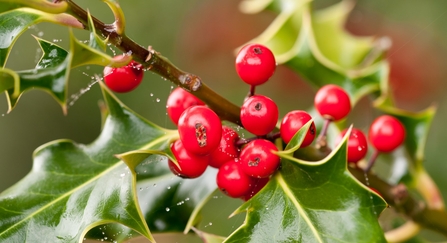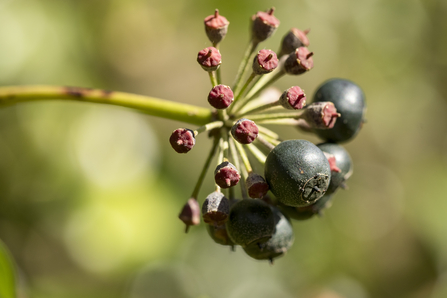As the cold sets in, our hedgerows come alive with vibrant berries, providing essential food for wildlife and a splash of colour to the autumn landscape. It’s the perfect time to spot these natural jewels.
What to see in November
Fieldfare feeding on Hawthorn © Chris Gomersall/2020VISION
Grey Squirrel eating Hawthorn berries © Chloe Valerie Harmsworth
In autumn, the Hawthorn tree’s pale pink or white flowers turn into ruby red berries called haws. These are eaten by a variety of creatures, including Grey Squirrels, and birds such as the Mistle Thrush and Redwing. Birds usually eat the fleshy part of the fruit, then spit the seed out. As a result, the Hawthorn seeds don’t travel far from the parent plant, meaning that over time the hedgerow thickens with this species. Other tree species that often accompany Hawthorn in a hedgerow include Holly and Blackthorn.

Holly berries © Ross Hoddinott/2020VISION
Also bearing red berries in autumn, the Holly tree has shiny, tough leaves that keep in moisture, allowing the tree to hold onto its leaves throughout autumn and winter. The spikiness of its leaves also makes this tree a useful barrier, including against browsing animals such as deer. The dense cover it provides year-round gives shelter to small mammals such as Hedgehogs. The red berries only grow on the female tree, and are another favourite of the Mistle Thrush. They are also enjoyed by Hedgehogs, Dormice and Wood Mice.

Ivy © Chris Lawrence
Unlike many other plants, Ivy flowers in late autumn, providing much-needed nectar for bees and wasps late in the year. The flowers develop into dark purple-blue-black berries for winter, which are beloved by birds such as the Blackcap and Blackbird. You can find Ivy almost everywhere, sometimes carpeting woodland floors or swaddling trees. It provides a vital sanctuary for overwintering insects such as Peacock, Small Tortoiseshell and Comma butterflies, and is a shelter and home for birds such as the Robin and Wren.
Spindle Berries © Philip Precey
In autumn, the Spindle tree is adorned with neon-bright pink fruit and orange seeds, and its narrow, oval leaves turn a reddish-orange. This tree has smooth green bark, grows up to nine metres in height and can live for 100 years. Its fruit and seeds are toxic to humans, but a valuable food source for Mice, Foxes and birds such as the House Sparrow. The tree gets its name from the fact that its straight, hard wood was traditionally used for making ‘spindles’ for spinning wool. It can be found in woodlands, hedgerows and often in parks.
Find out more about trees, plants and wildlife in autumn in The Secret Life of a Woodland Habitat: Life Through the Seasons by Chloé Valerie Harmsworth (see more about her book here).

